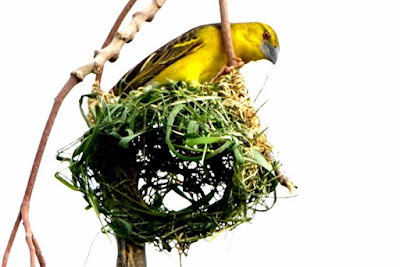 |
| Southern Masked Weaver(male) near Dete, Zimbabwe |
For six weeks I lived in Dete, a small town of about 3,000 people in western Zimbabwe on the border of Hwange National Park, while I was volunteering for a foundation that works with local communities. A dirt road separated my house from the bush and the nearby national park boundary. Early each morning I walked along the road observing and photographing birds. The abundance, diversity and beauty of Zimbabwe's birds were a continual source of enjoyment for me. Here are some that I managed to capture with my camera.
A female Southern Masked Weaver is inspecting a nest that appears to be undergoing repairs, as suggested by the juxtaposition of old and new grasses. The male builds the nest, and if the female accepts it she'll line the inside with soft plant materials. Like many weaver species, this one also nests in colonies.
The birds chatter away as they prepare their
nests. Each bird extracts a single blade of grass from the surrounding bush or
gardens and then flies back to the colony to weave it into the nest. Taking a
break to feed, small flocks of Southern-masked Weavers gorge on grass seeds or
forage for insects.
The Blue Wax Bill's
small size and habit of flitting quickly in and out of bushes made it difficult
for me to get a photo. I finally resorted to continuous burst shooting in hopes
that one of many images might come out in focus and with the bird acceptably
posed.
This is the stunning, yet somehow oddly put-together
Southern Red Bishop in full breeding regalia. He looks to me as though he'd
donned a red head scarf and then casually tossed the end around his neck before
showing up at his display site. Perched below him is his rather drab-colored
(potential) mate.
I loved watching
birds interacting. Sometimes an encounter lasted just long enough for one bird
to land and another, nearby, to fly off, clearly ceding space to the first; at
other times a prolonged interchange would occur.
These two African
Golden Orioles faced each other while one chirped at the other. Then they would
separate, likely foraging for insects, but never more than a couple meters
away. Then they came close together again, with more chirping, and again
separated. I couldn't tell if they were mates or a parent and offspring. After
a few minutes one flew off to another tree, and the bird remaining behind
suddenly changed its call from chirping to a lovely warble. Soon it, too, left
the tree and both flew out of my sight.
Late one afternoon, I
photographed these Arrow-marked Babblers through my open bedroom window as they
huddled together and engaged in mutual and self-preening.
They forage in small
groups of 9-12 and babble as they move through the lower strata of vegetation
and on the ground. The babbling probably serves to keep the group together.








No comments:
Post a Comment
Note: Only a member of this blog may post a comment.